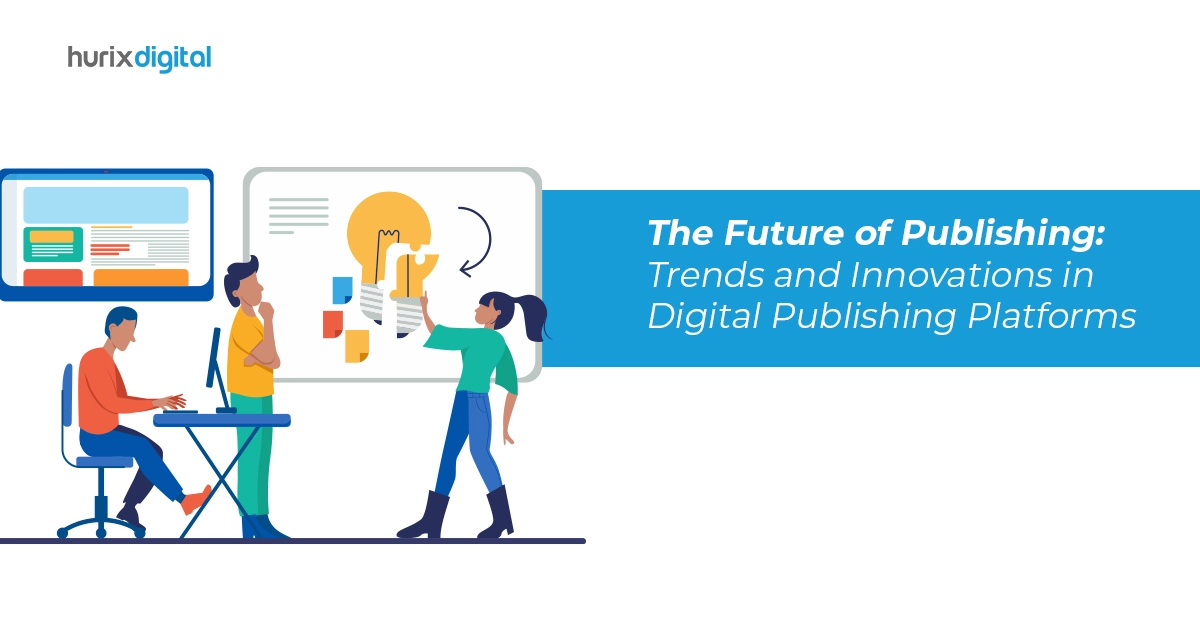
The Future of Publishing: Trends and Innovations in Digital Publishing Platforms
The world of publishing is undergoing a metamorphosis. And in this age, the evolution of publishing is more evident than ever before. From traditional print to digital platforms, the field of publishing is constantly evolving.
In particular, digital textbook platforms are experiencing a revolution, driven by technological advancements and changing consumer preferences.
The global eBook market is projected to reach a staggering $32.19 billion by 2032, showcasing the continued dominance of digital formats. This explosive growth presents a golden opportunity for publishers to not just survive but thrive.
In this post, we’ll cover some of the key trends and innovations reshaping the landscape of digital publishing platforms.
Table of Contents:
- Exploring the Power of Personalization with AI
- Voice Search Revolution: Optimizing for the Spoken Word
- Immerse Your Readers: The Rise of AR/VR Experiences
- Data Privacy: Balancing Transparency and User Experience
- Enhanced Accessibility Features: Reaching a Wider Audience
- Hurix Digital: Your Partner in the Digital Publishing Revolution
Exploring the Power of Personalization with AI
Imagine a world where your digital publication caters to each reader’s unique interests. Artificial intelligence (AI) is making this a reality.
Here’s how:
1. Recommendation Engines
AI algorithms can analyze reader behavior and suggest relevant content, keeping them engaged and coming back for more. These recommendation engines not only consider past reading preferences but also take into account factors like trending topics, similar readers’ interests, and real-time data analysis.
By continuously refining suggestions based on user interactions, publishers can increase reader satisfaction and retention.
2. Dynamic Content Delivery
Content personalization by AI delivery based on reader preferences, location, or even time of day ensures maximum relevance.
For instance, AI can adapt content formats, such as adjusting text size for different devices or presenting localized news stories based on the reader’s geographical location. This dynamic delivery enhances the user experience, making content consumption seamless and enjoyable across various contexts.
3. Interactive Learning
AI-powered chatbots can answer reader questions and provide personalized learning experiences within publications.
By leveraging this digital publishing trend, you can create a more captivating and interactive experience, fostering reader loyalty and boosting content consumption.
Also Read: PDFs 2.0: The Rise of Smart Remediation with AI and Automation
Voice Search Revolution: Optimizing for the Spoken Word
Gone are the days of laborious text searches. The rise of voice assistants like Siri and Alexa has ushered in the era of voice search. To thrive in this new reality, consider these steps:
1. Optimize for Voice Queries
Identify keywords and natural language phrases readers might use to search for your content and integrate them strategically. Conduct thorough keyword research to understand common voice search queries related to your content niche.
Additionally, consider the conversational tone of voice queries and adapt your content to match the way people speak naturally. By optimizing your content for voice queries, you increase the likelihood of appearing in voice search results and capturing relevant traffic.
2. Focus on Short, Concise Answers
Voice searches often prioritize concise responses. Ensure your content offers clear, bite-sized information that directly addresses the user’s query. Structure your content to provide succinct answers to common questions, using bullet points or numbered lists to enhance readability.
By delivering valuable information quickly and efficiently, you not only satisfy user intent but also increase the chances of being featured as a featured snippet in voice search results.
3. Focus on Readability
Complex sentence structures and jargon can be a barrier for voice assistants. Opt for clear, conversational language.
Optimizing for voice search ensures your content is readily accessible to a growing audience accustomed to navigating the digital world through spoken commands.
Immerse Your Readers: The Rise of AR/VR Experiences
Augmented Reality (AR) and Virtual Reality (VR) are revolutionizing the way readers interact with content.
Here’s how you can create immersive experiences with AR/VR:
- Interactive 3D Models: Imagine bringing complex scientific concepts or historical landmarks to life with interactive 3D models embedded within your digital publications.
- AR-Enhanced Learning: Overlay digital information and annotations onto physical objects, allowing readers to delve deeper into a topic through their smartphones or tablets.
- VR Storytelling: Transport readers to the heart of your narrative with VR experiences, fostering a deeper emotional connection with your content.
While AR/VR technology is still evolving, its potential to create truly immersive and engaging reading experiences is undeniable. Early adopters who experiment with these tools will be well-positioned to captivate readers in the years to come.
Data Privacy: Balancing Transparency and User Experience
The digital age revolves around data, but privacy concerns are paramount. Here’s how to strike a balance:
1. Communicate Data Practices
Be upfront with readers about the data you collect and how you use it. Offer them control over their information. Make sure you always provide clear and easily accessible information about your data collection practices.
This includes detailing what types of data are collected, how it is stored, and for what purposes it will be used. Transparency builds trust with your audience and empowers them to make informed decisions about their privacy.
2. Prioritize Opt-In Mechanisms
Ensure readers have a clear choice regarding whether or not to share their data and for what purposes. This way, they can actively consent to data collection and usage, empowering them to make informed decisions about their privacy.
3. Employ Secure Data Storage
Implement robust security measures to protect reader data from unauthorized access.
By prioritizing data privacy, you build trust with your audience and foster a positive user experience. Remember, a privacy-conscious approach isn’t just ethical; it’s good business.
Enhanced Accessibility Features: Reaching a Wider Audience
In today’s inclusive world, ensuring your digital publications are optimized with enhanced accessibility features is crucial.
Here’s how:
- Integrate Text-to-Speech Functionality: Allow readers with visual impairments to have their content read aloud through text-to-speech software.
- Offer Multiple Content Formats: Provide options like downloadable PDFs or ePUB files for readers who prefer a specific format.
- Incorporate Clear Visual Hierarchy: Structure your content with clear headings, concise paragraphs, and proper use of fonts and colors to enhance readability.
Implement these accessibility features to cater to a wider audience and demonstrate your commitment to social responsibility. This can enhance your brand image and attract a more diverse readership.
Also Read: Ethical Considerations in the Evolution of AI Copy Editing: Charting the Future Path of AI Services
Hurix Digital: Your Partner in the Digital Publishing Revolution
The digital publishing landscape is a dynamic and ever-evolving space. The trends and innovations discussed here represent just a glimpse of the exciting possibilities that lie ahead.
At Hurix Digital, we stay at the forefront of these advancements, helping businesses like yours navigate the changing landscape and unlock its full potential.
Our team of experts can assist you with:
- Developing engaging and interactive digital publications
- Leveraging AI for personalization and content optimization
- Optimizing for voice search and mobile accessibility
- Integrating cutting-edge technologies like AR/VR
Ready to future-proof your content and reach a wider audience? We’re here to guide you. Contact us today, and let’s embark on this digital publishing journey together!

Vice President – Digital Content Transformation. He is PMP, CSM, and CPACC certified and has 20+ years of experience in Project Management, Delivery Management, and managing the Offshore Development Centre (ODC).











